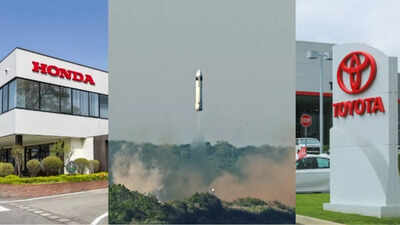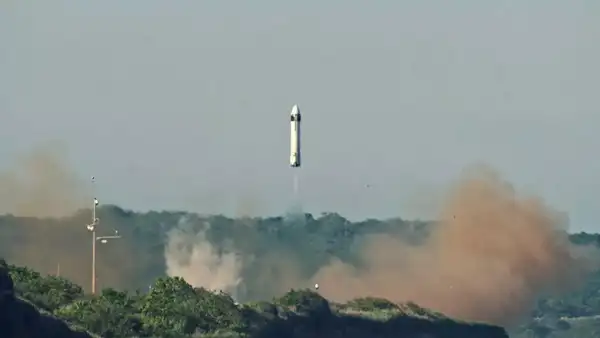
In a landmark achievement that’s turning heads across both the automotive and aerospace industries,
Honda
successfully launched and landed a reusable experimental rocket in June 2025. Conducted at its facility in Taiki, Hokkaido, the test saw the 6.3-meter-long rocket reach 271 meters in altitude before landing with remarkable precision, just 37 centimeters from its target. This makes Honda the first company outside the US and China to demonstrate working
reusable rocket technology
. While the brand is best known for two-wheelers and sedans, this move signals a bold diversification into space. But Honda isn’t alone; global automakers like Toyota and Geely are increasingly shifting gears into orbital ambitions. SpaceX is leading the private space industry with frequent launches, reusable rockets, and its Starlink satellite constellation, setting a benchmark that others now aim to match. The space race is no longer just for space agencies—it’s becoming an auto industry frontier.
Honda’s reusable rocket milestone
Honda’s test rocket, weighing around 1,312 kg when fully fueled, showcases years of behind-the-scenes work on spaceflight systems. Since 2021, the company has been developing core space technologies focused on reusable rocketry, precision landings, and stable autonomous flight. The successful test is just the first step; Honda aims to achieve suborbital launch capability by 2029, eventually entering the satellite deployment market. It sees space as a natural extension of its work in robotics, mobility, and renewable energy—fields that will all play vital roles in future off-world infrastructure.

Toyota’s space ambitions
Toyota, Japan’s largest automaker, has also been building its presence in the space sector. Through its subsidiary Woven by Toyota, the company plans to begin mass production of rockets in the early 2030s. Toyota’s strength in automation and manufacturing scalability gives it a competitive edge in producing reliable, cost-effective launch systems. Beyond rocketry, Toyota is also involved in lunar exploration, having partnered with JAXA (Japan’s space agency) to develop a crewed moon rover called the Lunar Cruiser. These ventures reflect Toyota’s vision of expanding mobility beyond the planet.
Tesla and SpaceX: Leading the charge
Tesla’s connection to the space industry runs deep through Elon Musk’s aerospace venture, SpaceX. While not directly part of Tesla, SpaceX is a pioneer in reusable rockets and satellite internet infrastructure. Its Falcon 9 and Starship programs have drastically lowered launch costs and made frequent space travel more viable. SpaceX’s Starlink satellite constellation already supports internet access worldwide, including for Tesla vehicles in remote areas. This synergy between automotive innovation and space infrastructure highlights how intertwined the two sectors have become.
Other automakers exploring space
Geely(China): The parent company of Volvo and Lotus, Geely operates Geespace, which plans to deploy hundreds of low-Earth orbit satellites to support autonomous driving and vehicle-to-everything (V2X) communication.Hyundai: Actively investing in lunar robotics and AI to support future space missions.These efforts suggest that space is becoming a common strategic frontier for automakers aiming to diversify their operations and technologies.
Why the auto industry is looking to the stars
As space becomes increasingly integral to communication, navigation, and data infrastructure, automakers are realizing they can no longer afford to stay grounded. With their deep expertise in systems engineering, manufacturing precision, and automation, car companies are uniquely positioned to contribute to and benefit from the booming space economy. From supporting autonomous vehicle connectivity to developing next-generation mobility platforms, the automotive industry sees the final frontier not just as an exploration challenge but as a strategic expansion of their core competencies. Here's why more automakers are now setting their sights on the stars:Satellite connectivity: Modern vehicles increasingly depend on satellite systems for real-time GPS navigation, over-the-air updates, vehicle-to-everything (V2X) communication, and autonomous driving technologies. By investing in space infrastructure, automakers can ensure more reliable, secure, and tailored connectivity services for their global fleets—especially in remote or underserved regions.Engineering expertise: Automakers have decades of experience in combustion systems, lightweight materials, aerodynamics, and mechatronics. These core engineering competencies translate directly into rocket design and space systems development, allowing them to innovate in areas like fuel efficiency, structural integrity, and advanced control mechanisms.Cost control: Relying on external providers for satellite launches or data access can be expensive and limiting. By developing in-house space launch capabilities or owning satellite constellations, companies can significantly reduce operational costs, gain better control over data infrastructure, and enhance independence in an increasingly competitive market.New revenue streams: Space opens up lucrative new business models—from deploying and operating satellite networks to offering space-based logistics, communications services, and even Earth observation data. These ventures allow automakers to diversify beyond vehicle sales and tap into the multibillion-dollar global space economy.Mobility evolution: The concept of mobility is evolving from road-based transport to interplanetary logistics. Automakers are exploring technologies for lunar rovers, Mars exploration vehicles, and orbital transportation. By participating in early space infrastructure, they aim to shape the future of off-Earth mobility, logistics, and life-support systems.

 6 hours ago
51
6 hours ago
51




























 English (US)
English (US)